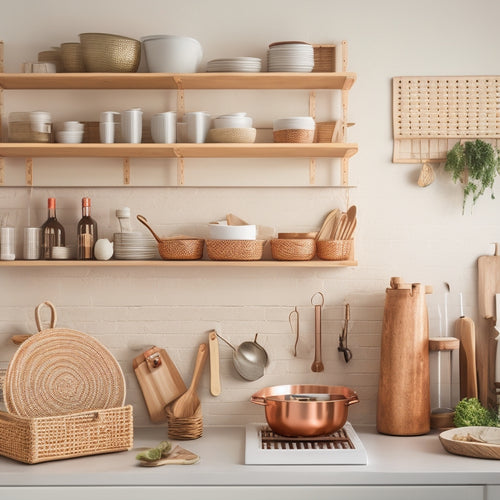
7 Essential Tips for a More Efficient Kitchen
Share
To create a more efficient kitchen, start by evaluating your workflow and identifying bottlenecks. Optimize corner spaces with carousels or lazy susans, and clear clutter from countertops to free up real estate. Designate a functional zone for meal prep, and position frequently used items within easy reach. Utilize vertical storage spaces with shelves and racks to maximize storage. Implement the 'golden triangle' concept by arranging your sink, stove, and refrigerator in a triangular formation to reduce steps during meal prep. By following these tips, you'll be well on your way to a more streamlined kitchen. Now, explore how to fine-tune these strategies to fit your unique cooking style.
Key Takeaways
• Assess kitchen workflow to identify bottlenecks and inefficiencies, and optimize meal prep and cooking efficiency.
• Utilize corner spaces, clear clutter, and install racks and shelves to maximize storage space and ensure item visibility and accessibility.
• Create functional kitchen zones by organizing the kitchen into stations, positioning frequently used items for easy access, and optimizing the layout for efficient workflow.
• Implement the golden triangle concept by arranging the sink, stove, and refrigerator in a triangle to reduce steps during meal preparation and increase productivity.
• Tailor the kitchen layout to fit your cooking habits, customizing station arrangement for efficiency and ensuring easy access to essential kitchen areas.
Assess Your Kitchen Workflow
Take a close look at how you move around your kitchen to identify areas where workflow can be improved. Are you constantly walking back and forth between the stove, fridge, and sink? Do you find yourself bumping into countertops or appliances? These kitchen habits can create workflow bottlenecks, slowing you down and making cooking a chore.
Observe your daily routines, such as preparing breakfast or cooking dinner. Where do you tend to pause or struggle? Maybe you're consistently reaching for a utensil that's just out of reach or juggling multiple pots and pans on the stovetop. These small inefficiencies can add up, making meal prep frustrating and tiring.
Optimize Corner Space Usage
Now that you've assessed your kitchen workflow, it's time to tackle those often-wasted corner spaces. You'll be surprised at how much more efficient your kitchen can be with the right solutions.
Corner Shelving Solutions
You can maximize the often-wasted space in your kitchen's corners with clever shelving solutions that provide easy access to infrequently used items. By installing shelves, carousels, or lazy susans, you can create a functional and organized corner area. This will help you store items like cookbooks, infrequently used kitchen gadgets, or special occasion dishes.
Here are some popular corner shelving solutions:
| Solution | Description | Benefits |
|---|---|---|
| Fixed Shelves | Stationary shelves that fit snugly into corners | Easy to install, affordable |
| Adjustable Shelves | Shelves that can be moved up or down to accommodate different item sizes | Versatile, customizable |
| Lazy Susans | Rotating shelves that make it easy to access items in the back | Convenient, space-saving |
| Corner Decor | Decorative shelves or carousels that add style to your kitchen | Aesthetically pleasing, functional |
When choosing a corner shelving solution, consider factors like the size of your kitchen, the type of items you want to store, and your personal style. Don't forget to add shelf liners to your new shelves to prevent items from slipping or falling. By optimizing your kitchen's corners, you'll create a more functional and peaceful cooking space.
Carousel Storage Systems
By incorporating a carousel storage system into your kitchen's corner space, you'll be able to effortlessly access and retrieve items without having to dig through cluttered shelves or countertops. This clever solution optimizes the often-wasted corner area, making it a valuable asset in your kitchen.
With a carousel storage system, you can store a multitude of items, from cookbooks to kitchen gadgets, in a compact and organized manner.
Look for features like Soft Close drawers or doors that guarantee smooth, quiet operation, and Adjustable Height settings that allow you to customize the storage to your needs. This flexibility is especially useful if you have family members with varying heights or mobility issues.
Streamline Countertop Real Estate
When it comes to streamlining your countertop real estate, you'll want to focus on creating a functional and efficient space. Start by identifying areas that tend to accumulate clutter and prioritize clearing those hotspots.
Clear Clutter Hotspots
Countertops, particularly those around sinks, stoves, and refrigerators, tend to become clutter hotspots, hindering workflow and creating a sense of chaos in the kitchen. These areas are clutter magnets, attracting items that don't belong, making it difficult to focus on cooking and preparing meals.
To clear these hotspots, start by identifying the items that contribute to the clutter. Are there dirty dishes piling up by the sink? Are there expired spices and condiments crowding the countertops around the stove?
Develop daily habits to maintain a clutter-free kitchen. Make it a point to wash dishes immediately after meals or load them into the dishwasher. Designate a specific spot for items like spices, oils, and condiments. Assign a home for utensils, gadgets, and appliances, and make sure they're put back after use.
Designate Task Zones
Designate Task Zones
To maximize efficiency, divide your countertop space into designated task zones, each equipped with the necessary tools and ingredients for a specific task, such as food preparation, cooking, or baking. This zone mapping approach allows you to focus on a single task at a time, reducing clutter and increasing productivity.
Task Segregation Table
| Task Zone | Essential Tools and Ingredients |
|---|---|
| Food Preparation | Cutting board, knives, utensils, ingredients |
| Cooking | Stovetop, pots, pans, cooking oil, spices |
| Baking | Mixing bowls, measuring cups, baking sheets, ingredients |
Optimize Corner Space
Now that you've designated task zones to boost efficiency, turn your attention to the often-wasted corner spaces, where clever storage solutions can free up valuable countertop real estate.
Don't let these areas collect dust and clutter — instead, optimize them with smart corner decor and space hacks.
Consider installing a carousel or Lazy Susan in a blind corner to make the most of the space.
You can also add a corner shelf or rack to store infrequently used items, keeping them out of the way but still accessible.
For a more creative solution, try a corner drawer or a pull-out trash can. These space-saving solutions will help you reclaim valuable countertop space and reduce clutter.
Create a Functional Zone
You'll want to assign a specific area of your kitchen as a functional zone, where you can prepare ingredients, cook, and serve meals efficiently. This zone should be designed to optimize your workflow, reducing walking distances and increasing productivity. To achieve this, consider an ergonomic layout that takes into account your height, reach, and movement patterns.
Conduct a workflow analysis to identify the activities that occur in your kitchen and the tools needed for each task. Then, organize your functional zone into stations that support these activities.
Here are some key considerations:
- Work surfaces: Make sure you have ample counter space for food preparation and cooking.
- Tool placement: Position frequently used utensils, pots, and pans within easy reach.
- Traffic flow: Design the zone to minimize congestion and collisions between cooks.
Position Frequently Used Items
How convenient is your kitchen when the items you use most are within easy grasp? Positioning frequently used items strategically can save you time and energy in the long run.
Start by identifying your item priority - which utensils, appliances, and ingredients do you reach for most often? Once you have your list, consider the access paths you take in your kitchen. Where do you tend to stand or move when preparing meals?
Place your high-priority items along these paths to minimize walking distances and maximize efficiency. For example, store your most-used spices near the stove or keep your favorite cooking utensils in a nearby drawer. By doing so, you'll reduce clutter and make meal prep a breeze.
Utilize Vertical Storage Space
By positioning frequently used items in easy-to-reach locations, you've already streamlined your kitchen workflow, but what about the often-wasted space above your countertops - can you capitalize on that too?
You can maximize your kitchen's potential by utilizing vertical storage space. This means making the most of the area above your countertops and taking advantage of your ceiling's height.
Here are some ways to do it:
-
Install Wall Shelves to store less frequently used items like special occasion dishes, cookbooks, or infrequently used kitchen gadgets.
-
Hang Ceiling Racks to store pots, pans, and utensils, keeping them organized and out of the way.
-
Use stackable containers or baskets to store dry goods like pasta, rice, or snacks, keeping them visible and easily accessible.
Implement a "Golden Triangle"
Implement a 'Golden Triangle'
Optimizing your kitchen's workflow is heavily influenced by the relationship between your sink, stove, and refrigerator, so arrange these essential stations in a triangular formation to minimize walking distances and maximize efficiency. This 'golden triangle' concept guarantees that you're not wasting time and energy moving between tasks. By positioning your workstation layout in this way, you'll reduce the number of steps you take during meal prep, making you more productive and efficient.
When designing your golden triangle, consider your cooking habits. If you tend to prep ingredients near the sink, place it at the apex of the triangle. If you're a frequent cook, the stove might be a better central point. The refrigerator should be easily accessible, but not so close that it obstructs your workflow.
Frequently Asked Questions
How Do I Declutter My Kitchen Without Getting Rid of Sentimental Items?
When decluttering your kitchen, you're torn between letting go and keeping sentimental items. You can compromise by implementing memory keeping strategies, like taking photos or creating a digital archive, to reduce emotional attachment and free up space.
Can a Kitchen Be Efficient With Limited Budget for Renovations?
You might think a kitchen renovation requires a hefty budget, but that's not necessarily true. With a little creativity, you can optimize your space and work within budget constraints to create a more efficient kitchen that feels tailored to you.
What Are Some Eco-Friendly Kitchen Storage Options Available?
You're looking for eco-friendly kitchen storage options! Consider Sustainable Shelves made from reclaimed wood or bamboo, and Recycled Racks crafted from repurposed materials, reducing waste and promoting a greener kitchen environment that you'll feel great about.
How Often Should I Clean My Kitchen to Maintain Efficiency?
You should establish a regular cleaning schedule to maintain kitchen hygiene, aiming to wipe down surfaces daily, deep clean weekly, and tackle clutter monthly to keep your kitchen running smoothly and efficiently.
Are There Specific Kitchen Layouts That Work Better for Left-Handed People?
You'll face unique Lefty challenges, so consider your spatial awareness when designing your kitchen layout. Opt for symmetrical countertops, strategically placed sinks, and cleverly positioned appliances to create a harmonious workflow that caters to your left-handed needs.
Related Posts
-

Revolutionize Your Kitchen Storage With These Ideas
You're ready to revolutionize your kitchen storage! Start by incorporating ladder-accessible shelves and utilizing cl...
-

Discover Luxurious Self-Care Essentials at Foundry Home
At Foundry Home, discover a curated world of luxurious self-care essentials, expertly designed to elevate relaxation ...

